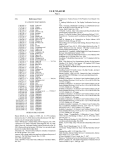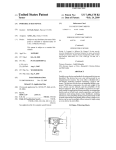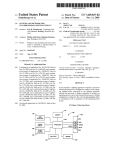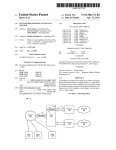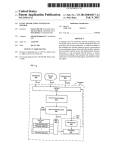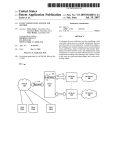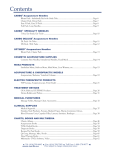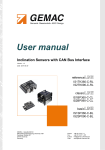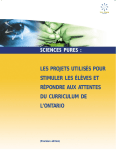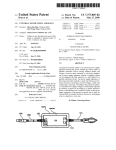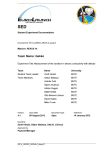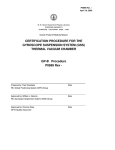Download Event notification system and method
Transcript
US008037212B2 (12) United States Patent Taylor et al. (54) EVENT NOTIFICATION SYSTEM AND METHOD (75) Inventors: Paulo Taylor, Amsterdam (NL); J an-Joost Rueb, Amsterdam (NL); Onno Bakker, Amsterdam (NL) 4/2009 Gruhl et a1. 12/2009 Blattner et a1. 7,730,144 B2 7,779,076 B2 7,933,957 B2 6/2010 Taylor et a1. 8/2010 Heikes et a1. 4/2011 Daniell 5/2002 10/2002 2003/0076367 A1 Notice: Subject to any disclaimer, the term of this patent is extended or adjusted under 35 4/2003 BencZe et a1. 11/2003 Haimberg 2003/0222907 A1 2003/0225846 A1 12/2003 Heikes et a1. 12/2003 Heikes et a1. (Continued) FOREIGN PATENT DOCUMENTS (21) Appl. No.: 11/637,514 Filed: 1292071 EP OTHER PUBLICATIONS Prior Publication Data US 2007/0168451A1 The International Search Report and Written Opinion for PCT appli cation PCT/IB2006/004204 Search Report dated Jan. 8, 2008. Jul. 19, 2007 Related US. Application Data (60) 9/2002 (Continued) Dec. 11, 2006 (65) Tamir et a1. ................. .. 345/745 Mendiola et a1. ........... .. 709/223 2003/0210265 A1 U.S.C. 154(b) by 489 days. (22) Oct. 11, 2011 7,523,138 B2 7,636,755 B2 2002/0063735 A1* 2002/0143916 A1* (73) Assignee: eBuddy Holding B. V., Amsterdam (NL) (*) US 8,037,212 B2 (10) Patent N0.: (45) Date of Patent: (Continued) Provisional application No. 60/748,988, ?led on Dec. 9, 2005. Primary Examiner * Tariq Ha?Z Assistant Examiner * Scott Sun (51) Int. Cl. (74) Attorney, Agent, or Firm * Sheppard Mullin Richter & G06F 3/00 G06F 13/00 (52) Hampton LLP (2006.01) (2006.01) US. Cl. ................ .. 710/22; 710/8; 710/36; 710/40; 710/62 (58) Field of Classi?cation Search ...................... .. None See application ?le for complete search history. (56) ABSTRACT A technique for user noti?cation involves modifying a title associated With a process to include information about an event that calls for user noti?cation. A method according to the technique may include running a process, processing an event, generating a string of characters that includes informa References Cited 6,415,318 6,484,196 6,571,234 7,389,324 7,426,382 7,496,379 (57) tion associated With the event, and displaying the string of U.S. PATENT DOCUMENTS 7/2002 AggarWal et a1. Bl 11/2002 Maurille B1 5/2003 Knight et a1. B1 6/2008 Masonis et a1. B2 9/2008 Aerrabotu et a1. B2 2/2009 Kaplan et al. B2 characters as a title associated With the process. A system constructed according to the technique may include a client, a title array, an event processing engine, and a title provision ing engine. 5 Claims, 11 Drawing Sheets 400 a 402 Run IM client process 404 No es 410 Terminate IM client? Yes 408 412 N Terminals IM client process Ye S 414 Modify title associated with IM client process US 8,037,212 B2 Page 2 US. PATENT DOCUMENTS 2004/0010808 2004/0054646 2004/0054802 2004/0158609 2004/0158610 2004/0221224 2005/0080867 2005/0097061 2005/0114454 2005/0187781 2005/0259656 2005/0268237 A1 A1 A1 A1 A1 A1 A1 A1 A1 A1 A1 A1 1/2004 3/2004 3/2004 8/2004 8/2004 11/2004 4/2005 5/2005 5/2005 8/2005 11/2005 12/2005 deCarmo Daniellet al. Beauchamp et al. Daniellet al. Davis et al. Blattner et al. Malik et al. Shapiro et al. D’Angelo et al. Christensen Dollaret al. Crane et al. 2006/0095562 A1 5/2006 Agarwalet al. 2006/0168054 A1 7/2006 Burkhart et al. 2006/0256816 2006/0265381 2006/0268828 2006/0271630 2006/0277053 2007/0043878 2007/0135099 2007/0136419 2007/0168451 2007/0168529 2007/0168558 2007/0192479 2009/0125591 A1 A1 11/2006 Yarlagadda et al. 11/2006 Altafetal. A1 A1 A1 A1 A1 A1 A1 A1 A1 A1 A1 11/2006 11/2006 12/2006 2/2007 6/2007 6/2007 7/2007 7/2007 7/2007 8/2007 5/2009 Yarlagadda Bensky et al. Lobb et al. Carlson et al. Taylor et al. Taylor et al. Tayloret al. Taylor et al. Taylor et al. Felten Kirkpatrick FOREIGN PATENT DOCUMENTS WO WO WO WO WO WO-9948011 WO-0120474 WO-0143357 WO-03-056764 WO-2004/031976 WO WO2005/074588 WO WO WO WO WO WO WO WO WO-2005/074588 WO-2006083820 WO-2007063041 WO-2007-110703 WO-2007-129143 WO-2007-129144 WO2008-072028 WO2008-072030 A1 A1 A2 A1 9/1999 3/2001 6/2001 7/2003 4/2004 A2 A1 A1 A3 A3 A3 A3 A3 8/2005 8/2006 6/2007 10/2007 11/2007 11/2007 6/2008 6/2008 8/2005 OTHER PUBLICATIONS The International Search Report and Written Opinion for PCT appli cation PCT/IB2006/004205 Search Report dated Jan. 8, 2008 10 pages. Co-pending U.S. Appl. No. 12/721,538, ?led Mar. 10, 2010. Co-pending U.S. Appl. No. 11/637,268, ?led Dec. 11, 2006. Co-pending U.S. Appl. No. 11/637,964, ?led Dec. 11, 2006. Co-pending U.S. Appl. No. 11/637,316, ?led Dec. 11,2006. Non-Final Of?ce Action mailed Jul. 30, 2009, in Co-Pending U.S. Appl. No. 11/637,954, ?led Dec. 11,2006. Notice ofAlloWance mailed Jan. 28, 2010, in Co-Pending U.S. Appl. No. 11/637,954, ?led Dec. 11,2006. Non-Final Of?ce Action mailed Sep. 3, 2009, in Co-Pending U.S. Appl. No. 11/637,964, ?led Dec. 11, 2006. Final Of?ce Action mailed Feb. 9, 2010, in Co-Pending U.S. Appl. No. 11/637,964, ?led Dec. 11,2006. Non-Final Of?ce Action mailed May 18, 2009, in Co-Pending U.S. Appl. No. 11/637,316, ?led Dec. 11,2006. Final Of?ce Action mailed Nov. 5, 2009, in Co-Pending U.S. Appl. No. 11/637,316, ?led Dec. 11,2006. Co-pending U.S. Appl. No. 12/774,700, ?led May 5, 2010. International Search Report for PCT application PCT/IB2006/04193 dated Jun. 24, 2008 (3 pages). International Search Report for PCT application PCT/IB2006/04200 dated Oct. 23, 2007 (2 pages). International Search Report and Written Opinion for PCT application PCT/IB2006/004204 Search Report dated Jan. 8, 2008 (11 pages). International Search Report for PCT application PCT/IB2006/ 004205 dated Apr. 2, 2008 (2 pages). Corrected International Search Report and Written Opinion for PCT application PCT/IB2006/004205 dated Apr. 4, 2008 (10 pages). International Search Report for PCT/IB2006/004264 dated Jun. 30, 2008 (3 pages). English abstract ofWO-2003-056764 dated Jul. 10, 2003 (2 pages). English Abstract of EP-1292071 dated Sep. 5, 2002 (1 page). Non-Final Of?ce Action mailed May 18, 2009 and Final Of?ce Action mailed Nov. 5, 2009 in Co-Pending U.S. Appl. No. 11/637,316, ?led Dec. 11,2006. Of?ce Action mailed on Mar. 21, 2011 in co-pending U.S. Appl. No. 11/637,268, ?led Dec. 11,2006. Of?ce Actions mailed on Dec. 30, 2009, Jun. 25, 2009, and Apr. 29, 2010 in co-pending U.S. Appl. No. 11/637,514, ?led Dec. 11,2006. Non-Final Of?ce Action mailed Jul. 30, 2009, in Co-Pending U.S. Appl. No. 11/637,954, ?led Dec. 11,2006. Notice ofAlloWance mailed Jan. 28, 2010, in Co-Pending U.S. Appl. No. 11/637,954, ?led Dec. 11,2006. Non-Final Of?ce Action mailed Sep. 3, 2009 and Final Of?ce Action mailed Feb. 9, 2010, in Co-Pending U.S. Appl. No. 11/637,964, ?led Dec. 11,2006. Of?ce Action mailed on Apr. 20, 2011 in co-pending U.S. Appl. No. 12/774,700, ?led May 5,2010. International Search Report and Written Opinion for PCT application PCT/IB2006/04200 Search Report dated Oct. 18, 2007, pp. 1-10. International Search Report and Written Opinion for PCT application PCT/IB2006/04193 Search Report dated Aug. 14, 2008, pp. 1-10. International Search Report and Written Opinion for PCT application PCT/IB2006/04264 Search Report dated Jun. 23, 2008, pp. 1-11. Co-pending U.S. Appl. No. US. Appl. No. 11/637,316, Co-pending U.S. Appl. No. Co-pending U.S. Appl. No. Co-pending U.S. Appl. No. Co-pending U.S. Appl. No. 11/637,954, ?led Dec. 11,2006. * cited by examiner 11/637,268, ?led Dec. 11, 2006. ?led Dec. 11,2006. 11/637,964, ?led Dec. 11, 2006. 12/721,538, ?led Mar. 10,2010. 12/774,700, ?led May 5, 2010. US. Patent 0a. 11, 2011 Sheet 3 0111 US 8,037,212 B2 3AFIG. US. Patent Oct. 11,2011 Sheet 4 0111 US 8,037,212 B2 mm.QE US. Patent 0a. 11, 2011 Sheet 5 0111 US 8,037,212 B2 Om.QE 235v US. Patent 0a. 11, 2011 1 US 8,037,212 B2 Sheet 7 0f 11 Start ) 402 i F Run IM client process 404 o _ Y [ 7 Proces 8 event Terminate IM client? Yes /. 410 408 412 No Terminate IM client process Y End es f 414 Modify title associated with IM client process M FIG. 4 US. Patent 0a. 11, 2011 Sheet 8 0111 ( Start US 8,037,212 B2 > y K 502 Open browser /- 504 Display in association with a browser a title associated with state of the browser 4 506 y / Receive an event trigger 508 y f Display in association with a browser a title associated with the event 51 0 Close browser? Yes N 512 Continue to display? Yes /. Close browser End FIG. 5 514 US. Patent Oct. 11, 2011 ( Sheet 10 0f 11 Start US 8,037,212 B2 > V f 702 K. 704 f. 706 /. 708 f. 710 Process event that ca lls for user noti?cation 7 Generate a ?rst string of characters associated with the event V Store the ?rst string of characters in an array Providing the ?rst string of chara cters from the array to a process V Using the ?rst string of characters as a title in association with the process /. 712 Providing a second string of chara cters from the array to the process V r Using the second string of characters as a title in association with the process End FIG. 7 714 US. Patent Oct. 11,2011 Sheet 11 0111 US 8,037,212 B2 800 a Computer 8_O_ ’ Processor 1m Comm Interface & Memory @ K- 820 Display Control QM NV Storage m l/O Control m Display Device @? I/O Devices 80_4 FIG. 8 US 8,037,212 B2 1 2 EVENT NOTIFICATION SYSTEM AND METHOD includes information associated with the event. The method may further include displaying the string of characters as a title associated with the process. A system constructed according to the technique may include a client, a title array, CROSS-REFERENCE TO RELATED APPLICATIONS an event processing engine, and a title provisioning engine. BRIEF DESCRIPTION OF THE DRAWINGS This Patent Application claims priority to US. Provisional Patent App. No. 60/748,988, ?led Dec. 9, 2005, which is incorporated herein by reference. This Patent Application is related to US. patent application Ser. Nos. 11/637,954, 11/637,268, 11/637,964, 11/637,316, to Taylor, et al., respec Embodiments of the inventions are illustrated in the ?g ures. However, the embodiments and ?gures are illustrative rather than limiting; they provide examples of the invention. tively entitled HIGH LEVEL NETWORK LAYER SYSTEM AND METHOD, PICTURE PROVISIONING SYSTEM AND METHOD, MESSAGE HISTORY DISPLAY SYS TEM AND METHOD, and CONTACT LIST DISPLAY SYSTEM AND METHOD, ?led concurrently herewith and FIG. 1 depicts an example of a system for providing instant messages to clients via a web interface. FIG. 2 depicts an example of a system for displaying con tent from an IM client at an alternative IM client. FIGS. 3A-3D depict examples of screenshots with IM noti incorporated by reference herein. ?cation functionality. BACKGROUND 20 Instant messaging requires the use of a client program that hooks up an instant messaging service and differs from e-mail in that conversations are then able to happen in real time. Mo st services offer a presence information feature, indicating whether people on one’s list of contacts are currently online and available to chat. This may be called a contact list. In early instant messaging programs, each letter appeared as it was typed, and when letters were deleted to correct typos this was also seen in real time. This made it more like a telephone conversation than exchanging letters. In modern instant mes FIG. 4 depicts a ?owchart of an example of a method for changing a title associated with a titlebar. FIG. 5 depicts a ?owchart of an example of a method for displaying an event-related title. FIG. 6 depicts an example of a system for programmed text event-speci?c title provisioning. 25 FIG. 7 depicts a ?owchart of an example of a method for displaying programmed text ?les. FIG. 8 depicts a computer system suitable for implemen tation of the techniques described above with reference to FIGS. 1-7. 30 saging programs, the other party in the conversation generally DETAILED DESCRIPTION only sees each line of text right after a new line is started. Most instant messaging applications also include the ability to set a status message, roughly analogous to the message on a tele In the following description, several speci?c details are presented to provide a thorough understanding of embodi phone answering machine. 35 Popular instant messaging services on the public Internet include .NET Messenger Service, MSN Messenger, AOL out one or more of the speci?c details, or in combination with Instant Messenger, Excite/Pal, Gadu-Gadu, Google Talk, iChat, ICQ, Jabber, Qnext, QQ, Meetro, Skype, Trillian and Yahoo! Messenger. These services owe many ideas to an other components, etc. In other instances, well-known imple 40 older (and still popular) online chat medium known as Inter net Relay Chat (IRC). The foregoing examples of the related art and limitations related therewith are intended to be illustrative and not exclu sive. Other limitations of the related art will become apparent to those of skill in the art upon a reading of the speci?cation ments of the invention. One skilled in the relevant art will recogniZe, however, that the invention can be practiced with 45 and a study of the drawings. SUMMARY mentations or operations are not shown or described in detail to avoid obscuring aspects of various embodiments, of the invention. FIG. 1 depicts an example of a system 100 for providing instant messages to clients via a web interface. In the example of FIG. 1, the system 100 includes a network 102, a server 104, and an Instant Messenger (IM) server 106, and an IM network 108. The server 104 is coupled to the network at least by way of port 80. The two way communication via port 80 is represented in the example of FIG. 1 as an arrow 110. The 50 server 104 is coupled to the IM server 106 via one or more The following embodiments and aspects thereof are other ports. The two way communication via the other ports is described and illustrated in conjunction with systems, tools, represented in the example of FIG. 1 as an arrow 112. The IM server 106 is coupled to the IM network 108 via any known or convenient mechanism. Indeed, the IM server 106 may be thought of as part of the IM network 108. The network 102 and methods that are meant to be exemplary and illustrative, not limiting in scope. In various embodiments, one or more of the above-described problems have been reduced or elimi nated, while other embodiments are directed to other 55 couples a plurality of clients 114-1 to 114-N (referred to collectively as clients 114) to the server 104. In the example improvements. A technique for user noti?cation involves modifying a title of FIG. 1, the server 104 includes an event queue 116. The network 102 may include by way of example but not associated with a process to include information about an event that calls for user noti?cation. A method according to 60 the technique may include running a process, such as, by way of example but not limitation, an IM client process, a browser, work, phone network, radio network, or some other known or convenient network. The term “Intemet” as used herein refers to a network of networks that uses certain protocols, such as or some other process that has a title associated therewith. The TCP/IP, and possibly other protocols such as the hypertext method may further include processing an event, such as by way of example but not limitation, a new mail event, a new instant message event, a reminder event, a calendar event, or some other event, and generating a string of characters that limitation LAN, WAN, VLAN, WLAN, Internet, cellular net 65 transfer protocol (HTTP) for hypertext markup language (HTML) documents that make up the World Wide Web (the web). The physical connections of the Internet and the pro US 8,037,212 B2 3 4 tocols and communication procedures are Well known, but any convenient physical connections or protocols could be used. 104, With the IM protocol on the application side. In a non limiting embodiment, the compliant port is http port 80. HoW ever, any port having similar characteristics to those of a The server 104 may include a multiple servers. Indeed, it typical port 80 could be used. may be desirable, depending upon details of a particular The latest available broWsers, as of December 2005, enable the use of a technique calledAJAX (Asynchronous JavaScript implementation, to install several servers to cope With the number of simultaneous users the system 100 supports. It And XML). WithAJAX, appropriately con?gured clients 114 may further be desirable, depending upon details of a particu can execute actions and poll for messages or events using only JavaScript. The method is based on using an XMLHttpRe quest object to make HTTP requests to the server 104. The server 104 may reply With messages taken from the queue of lar implementation, for the server 104 to have a high CPU throughput, together With large amounts of RAM, to handle a large number of users. It may further be desirable, depending upon details of a particular implementation, to accomplish resource sharing via thread handling Where a pool of threads the corresponding session in XML (or another) format that are parsed and displayed according to the message content. For clients 114 that include a broWser, When accessing the is shared and used by one or more of the clients 114 for client-server communication and betWeen the server 104 and server 104 the broWser typically uses hidden HTML frames to the IM server 106. The server 104 may include one or more of an application server, database server, Web server, banners server, and con tent server, or any combination thereof. To make the most of the techniques described herein, the server 104 should, though is not required to, include at least one application 20 update information on visible frames. The visible frames display appropriate information While the hidden frames are reloaded in short periods of time. In each refresh that hits the server 104, the broWser identi?es the current messaging ses sion and checks if neW events or messages associated With the session are in the event queue 116. When neW information server. The other servers can have supporting roles in, by Way of example but not limitation, serving static content or adver arrives and needs to be displayed in some form, the broWser tising (e.g., banners), storing usage data, or ful?lling some makes use of, for example, JavaScript code to update the other knoWn or convenient function. 25 visible frames and WindoWs With neW messages or events 30 keeping the information up to date in the screen. In this Way, automatic refreshing can take place in a hidden frame. In another embodiment, certain of the clients 114 With broWsers may not make use of refreshes. For example, a form of updating the screen Without using a refresh technique is to The server 104 may act as a proxy server betWeen the clients 114 and the IM server 106. The server 104 receives communications from the clients 114 on http port 80, and responds to the clients 114 on http port 80. Communications from the clients 114 that are bound for the IM netWork 108, hoWever, must also come through http port 80 to the server 104, and are then forwarded to the IM server 106. In this Way, keep one single HTTP socket request alive for the Whole period of a messaging session Without actually closing the the server 104 acts as a carrier of the data from users to the IM netWork 108 using a mechanism that controls and manages the data (e.g., text messages, display images, emotions, 35 audio/video streams, etc.) sent betWeen one of the clients 114 and the server 104, and vice versa. The IM server 106 may be any knoWn or convenient IM server that is compatible With IM. Events, messages, or other appropriate data from the IM server 106 are collected in the event queue 116 of the server 104. The events may be col socket connection. In this example, information is initially loaded and displayed in one single visible frame. While events and messages are being received by the server 104, JavaScript code can be injected into the HTML document through the same HTTP socket kept alive and managed by the server 104. For each event or message, the broWser can inter pret the JavaScript code injected and the corresponding parts 40 lected in association With a variety of protocols including by Way of example but not limitation port 1863, port 5050, port 5222, port 5190, etc. of the HTML document and WindoWs Will be updated. In another embodiment, certain of the clients 114 With broWsers may make use of manual refreshes. Some relatively unsophisticated broWsers, such as WAP and XHTML broWs ers often available on mobile phones, do not support hidden The IM netWork 108 may include one or a combination of 45 frames and/ or JavaScript (and others may be con?gured such netWorks selected from MSN Messenger, Yahoo! Messenger, AIMAOL, ICQ, QQ, Jabber, Google Talk, IRC, or some other that they do not support hidden frames and/or JavaScript). In such cases, the information displayed has to be updated manually by the user. Manual updating enables any mobile knoWn or convenient IM netWork. The clients 114 may include any knoWn or convenient device, including by Way of example but not limitation, a Web broWser, mobile client, PDA, game console, TV box, native 50 phone, PDA, TV Set or any device With a broWser to connect to the server 104 and use the messaging platforms made available by the server 104 assuring the communication application, etc. The clients poll the server 104 for events. The betWeen the clients 114 and the IM server 106. events can be removed from the event queue 116 and trans lated into text, JavaScript, XML, or some other knoWn or convenient format that one or more of the clients 114 need or Message history canbe stored by most IM clients on a local computer. For alternative Web and mobile-based clients local storage may not be possible. In a non-limiting embodiment, the server 104, may have the capability to store message 55 expect in order to process data associated With the event. To interact With the IM netWork 108, the clients 114 send data to the server 104. The data, Which may include com history from IM conversations done via one or more of the clients 114. The message history can be accessed and mands, is processed and translated into corresponding data that Will be sent to the appropriate IM netWork. In an embodi searched at any time via the server 104 by one or more of the 60 ment, the appropriate IM netWork may be determinable based upon the protocol encoded in a message. content from an IM client at an alternative IM client. In the example of FIG. 2, the system 200 includes a client 202, an Messages or actions from the clients 114 are collected over netWork protocols such as, by Way of example but not limi tation, HTTP or plain socket connections. The messages or actions are transformed to an appropriate protocol format to be sent over a compliant port from the clients 114 to the server clients 114 FIG. 2 depicts an example of a system 200 for displaying IM netWork 204, a server 206, an IM netWork 208, a client 65 210, other IM netWorks 212-1 to 212-N (referred to collec tively as other IM netWorks 212), and other clients 214-1 to 214-N (referred to collectively as other clients 214). US 8,037,212 B2 5 6 For illustrative purposes, it is assumed that the client 202 has content that is compatible with the IM network 204. been received. The exact information in a titlebar, taskbar, or However, the client 210 is capable of reading content format ted to be compatible with the IM network 208. Thus, in bar 312 is simply illustrative. When an event, message, or other data is available to the client, the titlebar 312 may change to show information about the event. If properly con ?gured, the taskbar item 310 and the titlebar 312 could even other display area is implementation speci?c. Thus, the title operation, the server 206 collects content from the client 202 (either through the IM network 204, as shown in FIG. 2, or directly from the client 202, such as is shown by way of display different information (though in a typical implemen example in FIG. 1). The server 206 then formats the content as appropriate for use on the IM network 208. Once the content is properly formatted, it can be made available to the client tation the text is identical, albeit often necessarily shortened on the taskbar). The title can be used to notify users of certain events by changing the title of the IM client. The changing of the text in the taskbar and/ or titlebar may stand out from other taskbars and/or with ?xed texts. FIG. 4 depicts a ?owchart 400 of an example of a method for changing a title associated with a titlebar (and an associ 210 (either through the IM network 208, as shown in FIG. 2, or directly to the client 210, such as is shown by way of example in FIG. 1). Depending upon the embodiment and/or implementation, the content may also be formatted as appro priate for one or more of the other IM networks 212, to be made available for one or more of the other clients 214. As is well-understood, different devices provide different ated taskbar item, if applicable). In the example of FIG. 4, the functionality. For example, a desktop typically provides ?owchart 400 starts at module 402 where an IM client process greater storage, greater display area, and greater power than a cell phone. Thus, at best, an IM client must work under the is running. The IM client process may include, by way of 20 constraints imposed by a particular device. Depending upon the device, certain functionality may be more useful. For example, a device may have inferior capabilities with respect has been received. If it is determined that an event has not to notifying a user when a message is received. The device capabilities may limit the way in which a user can be noti?ed when a message is received. The environment in which a user operates may provide another limitation. For example, a user at work may not want to play a noise or have a popup window show up every time a message is received. Similarly, a user who gets lots of messages may not want to hear the noise or see the popup windows because of the great 25 continues to module 408 where the IM client process is ter 30 (406-N) then the ?owchart 400 loops back to decision point In the example of FIG. 4, eventually, assuming the IM 35 FIGS. 3A-3D depict examples of screenshots 300 with IM noti?cation functionality. The bar may be a titlebar, a taskbar, In the example of FIG. 4, the ?owchart 400 continues to decision point 412 where it is determined whether noti?ca 3A, the taskbar includes a process identi?ed by the taskbar 40 tion is called for. Events may or may not result in noti?cation of a user, depending upon the event, embodiment, implemen tation, device limitations, and/or user’s IM client con?gura 45 buddy.com, the taskbar item 304 now indicates that a new tion. If it is determined that user noti?cation is called for (412-Y), then the ?owchart 400 continues to module 414 where a title associated with the IM client process is modi?ed. If, on the other hand, it is determined that user noti?cation is not called for (412-N), or in any case after module 414, the ?owchart 400 loops back to decision point 406, as described above. message is available. The IM noti?cation functionality may be cool on a desktop, but can be particularly useful in other implementations. client process is not terminated (408), it is determined that an event has been received (404-Y), and the ?owchart 400 con tinues to module 410 where the event is processed. Events are processed in a known or convenient manner. or some other menu or display item. In the example of FIG. In the example of FIG. 3B, the taskbar includes the Fire fox® web browser process, but the taskbar item 304 appears differently. Speci?cally, rather than depicting the site www.e is determined that the IM client process is not to be terminated 404, as described above. can take place in a titlebar, which is great for devices that have inferior noti?cation functionality, and great for users who item 302. For illustrative purposes, the process is a Firefox® web browser that is at the site www.ebuddy.com. The screen shot appears as a conventional screen might look. However, when a new message arrives, the taskbar changes. been received (404-N), then the ?owchart 400 continues to decision point 406 where it is determined whether to termi nate the IM client process. If it is determined that the IM client process is to be terminated (406-Y), then the ?owchart 400 minated, and the ?owchart 400 ends. If, on the other hand, it frequency with which it occurs. Advantageously, noti?cation want a subtle noti?cation. example but not limitation, a browser. In the example of FIG. 4, the ?owchart 400 continues to decision point 404 where it is determined whether an event 50 Modifying the title (414) presumably modi?es the display For example, notifying a user when new messages arrive or in the applicable titlebar and/or the display in the applicable events happen can gracefully be done by a native IM appli cation. However, for alternative web clients this is more dif taskbar item. Conventional browsers typically do not allow setting a title in a titlebar that is different from the correspond ing taskbar item. However, a display area could display infor ?cult given the nature of control from within a browser to the Operating System. There is less control for alerts like ?ashing 55 windows etc. from browsers. In such cases, it may be particu larly advantageous for a server to be able to provide a user with alerts for new messages or events using the title bar, task bar, or other display area of a browser. In the example of FIG. 3C, the Firefox® browser is open, 60 and the taskbar item 306 indicates the current site is www.e buddv.com. The titlebar 3 08 includes similar information. If a new mes sage is received, then both the titlebar and the taskbar can be changed. In the example of FIG. 3D, the taskbar includes the Fire fox® web browser with a changed taskbar item 310. The titlebar 312 is also changed to indicate a new message has mation different from that of the title, if con?gured appropri ately. Moreover, future browsers may include functionality that allows displaying different titles in the titlebar and the taskbar. The title of the application may or may not keep the changed value until the user takes some action (e.g., clicking on the taskbar item associated with the IM client process). For example, the original title could be displayed after a certain amount of time has passed (e. g., a “new message” title could last for 10 seconds before reverting to the original title). FIG. 65 5 depicts a ?owchart 500 of an example of a method for displaying an event-related title. In the example of FIG. 5, the ?owchart 500 starts at module 502 where a browser is opened. US 8,037,212 B2 8 7 In the example of FIG. 5, the ?owchart 500 continues to device 602, the network 604, and the output device 606 are coupled to the computer 610 using the interface 612. An event received on the interface 612 (from either the input device 602 or the network 604) is provided to the event processing engine 614 for processing in a known or conve nient manner. The event processing engine 614 may be module 504 a title associated with state of a browser is dis played in association with the browser. The state of the browser may include, for example, a current site for which the browser is displaying a page, as is shown in FIGS. 3A and 3C. In general, the title associated with state of the browser includes any title that would normally be displayed in asso ciation therewith prior to updating the title in response to an embodied in a computer-readable medium. If user noti?ca tion is desired for the event, the user can be noti?ed in any event noti?cation. known or convenient manner. In the example of FIG. 5, the ?owchart 500 continues to Advantageously, data associated with the event can also (or module 506 where an event trigger is received. The event trigger is associated with an event that calls for notifying a user. For example, the event trigger may include receipt of a in the alternative) be provided to the title provisioning engine new instant message. provisioning engine 616 inputs title strings, which are strings 616. The title provisioning engine 616 may be embodied in a computer-readable medium. In the example of FIG. 6, the title In the example of FIG. 5, the ?owchart 500 continues to of characters, to the title array 618. The title array 618 includes N-1 title array strings, embodied in a computer readable medium, which are referenced (for illustrative pur module 508 where a title associated with the event is dis played in association with the browser. Thus, the title associ ated with the state of the browser is replaced by the title associated with the event. Moreover, in a non-limiting 20 to rewrite the entire title array 618 with title strings associated embodiment, the state of the browser is unchanged (other than the title, of course). In the example of FIG. 5, the ?owchart 500 continues to decision point 510 where it is determined whether to close the browser. If the browser is not to be closed (510-N), then the ?owchart 500 continues to decision point 512 where it is determined whether to continue to display the title associated with the event. If so (512-Y), then the ?owchart 500 loops back to module 508, as described previously. If not (512-N), then the ?owchart 500 loops back to module 504, as described with the mo st recent events. Alternatively, a given event may cause the title provisioning engine 616 to append title strings to the end of the title array 618. In a non-limiting embodi 25 excluding redundant data (e.g., data that is already repre sented in the title array 618). 30 35 should not longer be displayed. If, on the other hand, the as such. 40 noti?ed of events in the taskbar, while they are using another application. The changing taskbar would bene?t clients on devices using a desktop system that allows multiple applica 45 50 55 device 602, a network 604, an output device 606, and a computer 610. The input device 602 may be any known or However, in a non-limiting embodiment, the title provi sioning engine 616 controls the title generator 626 to either generate a title in the usual way (e.g., using the state of the Thus, title string 624, which is embodied in a computer readable medium in association with the display, will include either a title generated in accordance with the state of the client 622 or a title string from the title array 618 (speci?cally, the title array string selected by the multiplexer 620). The display (e.g., a window including the title string 624) is pro convenient device that is capable of generating or forwarding 60 vided to the interface 612 for display on the output device 606. 65 have display limitations associated with the client 622, the operating system, the output device 606, or other factors, creative control of the title array 618 can yield interesting title display characteristics. For example, the title can appear to Advantageously, although the title string 624 is likely to 604. Most computers include output devices for on which a variety of output is displayed. The computer 610 includes an interface 612, an event processing engine 614, a title provisioning engine 616, a title array 618, a multiplexer 620, and a client 622. The interface 612 may include an implementation-speci?c number of dif ferent kinds of known or convenient interfaces. The input email client, a VolP client, or some other communications related client. The client 622 may include a window, panel, or some other display that includes a title. The title generator 626 generates a title for the display in a known or convenient client 622 to determine an appropriate title), or to not generate a title because a title string is available from the title array 618. Advantageously, in an embodiment, a title associated with an event can include programmed text effects. FIG. 6 depicts an example of a system 600 for programmed text event events to the computer 610. In a typical implementation, events will be received at the computer 610 via the network In the example of FIG. 6, the client 622 includes a title string 624 and a title generator 626. The client 622 may include, by way of example but not limitation, an IM client, an manner. (as in FIGS. 3A, 3B). speci?c title provisioning. The system 600 includes an input 620 is a conceptual construct that is intended to illustrate selecting one of the title array strings using an index to the title array 618. Thus, the multiplexer 620 may or may not be embodied in a computer-readable medium. It should be noted that the multiplexer 620, in at least one embodiment, is not a hardware MUX, though it could conceivably be implemented a window and in the taskbar. Advantageously, users can be tions to run at the same time, eg Mail client, Browser, IM, etc. While users are switching between various applications and an IM client they may not be aware of new messages/ events that have arrived. The alternating messages can be seen in a taskbar even if, for example, the browser window is minimized or behind other application or browser windows In the example of FIG. 6, the multiplexer 620 selects one of the title array strings for provisioning to the client 622. The multiplexer 620 receives a control signal from the title pro visioning engine 616 to accomplish this task. The multiplexer display the title associated with the event may be based upon, by way of example but not limitation, a noti?cation timer, an browser is to be closed (510-Y), then the ?owchart 500 con tinues to module 514 where the browser is closed, and the ?owchart 500 ends. The title of, e.g., a window shows up in both the titlebar of ment, the title provisioning engine 616 updates the current title array 618 by adding new data associated with an event, previously. The determination as to whether to continue to event-speci?c timer, a user action, or some other action that is suf?cient to indicate that the title associated with the event poses) as title array string [0] to title array string [N]. A given event may cause the title provisioning engine 616 have scrolling text, blinking, alternating upper and lower case, etc. US 8,037,212 B2 10 Scrolling text may be accomplished by cycling through the string of characters is repeated as a title, another event is processed, a third string of characters is provided, or with title array 618 over time. After the title array string [N] is displayed, the title array 618 can start over at title array string [0], or allow the title generator 626 to generate a title instead. The scrolling text could include the actual message of an IM message, displayed in the title over time, the scrolling text could scroll through a list of senders of email that has not yet some other applicable module or sequence of modules. FIG. 8 depicts a computer system 800 suitable for imple mentation of the techniques described above with reference to FIGS. 1-7. The computer system 800 includes a computer 802, I/O devices 804, and a display device 806. The computer been checked. Blinking can be accomplished by, conceptu ally, making every other title array string blank. Alternatively, 802 includes a processor 808, a communications interface a NULL string could be periodically provided instead of a title array string. The number of programmed text effects available to those of ordinary skill in the art of computer age 816, and I/O controller 818. The computer 802 may be coupled to or include the I/O devices 804 and display device 810, memory 812, display controller 814, non-volatile stor 806. programming, with this teaching before them, are practically The computer 802 interfaces to external systems through impossible to list exhaustively so no effort is made to do so 7, the ?owchart 700 starts at module 702 where an event that the communications interface 810, which may include a modem or network interface. The communications interface 810 can be considered to be part of the computer system 800 or a part of the computer 802. The communications interface 810 can be an analog modem, ISDN modem, cable modem, calls for user noti?cation is processed. It may be noted that token ring interface, satellite transmission interface (e.g. herein. FIG. 7 depicts a ?owchart 700 of an example of a method for displaying programmed text titles. In the example of FIG. whether the event calls for user noti?cation may or may not be 20 “direct PC”), or other interfaces for coupling a computer system to other computer systems. Although conventional known until after the event is processed. In the example of FIG. 7, the ?owchart 700 continues to module 704 where a ?rst string of characters associated with computers typically include a communications interface of the event is generated. There may or may not be a second, include one, thereby making the communications interface third, etc. string of characters associated with the event gen some type, it is possible to create a computer that does not 25 In the example of FIG. 7, the ?owchart 700 continues to module 706 where the ?rst string of characters is stored in an array. The array may include other strings of characters asso ciated with other events, or the ?rst string of characters (and limitation, a conventional microprocessor such as an Intel Pentium microprocessor or Motorola power PC microproces sor. While the processor 808 is a critical component of all 30 second, third, etc. string of characters) associated with the event may replace all current characters strings of the array. In the example of FIG. 7, the ?owchart 700 continues to module 708 where the ?rst string of characters is provided from the array to a process. The process may include, by way of example but not limitation, an IM client operating in a Windows® environment. In the example of FIG. 7, the ?owchart 700 continues to module 710 where the ?rst string of characters is used as a title in association with the process. For example, if the pro conventional computers, any applicable known or convenient processor could be used for the purposes of implementing the techniques described herein. The memory 812 is coupled to 35 40 the processor 808 by a bus 820. The memory 812, which may be referred to as “primary memory,” can include Dynamic Random Access Memory (DRAM) and can also include Static RAM (SRAM). The bus 820 couples the processor 808 to the memory 812, and also to the non-volatile storage 816, to the display controller 814, and to the I/O controller 818. The I/O devices 804 can include a keyboard, disk drives, printers, a scanner, and other input and output devices, includ ing a mouse or other pointing device. For illustrative pur poses, at least one of the I/O devices is assumed to be a cess is an IM client operating in a Windows® environment, the ?rst string of characters could be used such that the win dow associated with the IM client includes the ?rst string of characters (or at least the ?rst subset of the ?rst string of characters, if the window is too small to display the entire 810 optional in the strictest sense of the word. The processor 808 may include, by way of example but not erated, as well. block-based media device, such as a DVD player. The display controller 814 may control, in a known or convenient manner, 45 a display on the display device 806, which can be, for string) in the titlebar. Similarly, in this speci?c example, the example, a cathode ray tube (CRT) or liquid crystal display ?rst string of characters could be displayed in a taskbar item associated with the IM client. In the example of FIG. 7, the ?owchart 700 continues to module 712 where a second string of characters is provided from the array to the process. The second string of characters (LCD). 50 The display controller 814 and I/O controller 818 may include device drivers. A device driver is a speci?c type of computer software developed to allow interaction with hard 55 municating with the device, through a bus or communications subsystem that the hardware is connected to, providing com mands to and/ or receiving data from the device, and on the other end, the requisite interfaces to the OS and software ware devices. Typically this constitutes an interface for com could be associated with the same event as the ?rst string of characters, an earlier event (where the second string remains in the array), or a later event (where the second string replaces or is in addition to strings associated with the last processed event). The second string of characters could also be unasso ciated with an event. For example, the second string of char acters could be a NULL string that has the effect of causing applications. The device driver may include a hardware-dependent com puter program that is also OS-speci?c. The computer pro the ?rst string of characters (if provided before and after the second string of characters) to blink or ?ash. In the example of FIG. 7, the ?owchart 700 continues to module 714 where the second string of characters is used as a title in association with the process. Then the ?owchart 700 ends. It should be noted that the ?owchart 700 simply illus trates a ?rst and second string of characters from the array being used as a title, and then ends. Of course, the ?owchart could continue with modules (not shown) where the ?rst gram enables another program, typically an OS or applica 60 tions software package or computer program running under the OS kernel, to interact transparently with a hardware device, and usually provides the requisite interrupt handling necessary for any necessary asynchronous time-dependent hardware interfacing needs. 65 The non-volatile storage 816, which may be referred to as “secondary memory,” is often a magnetic hard disk, an optical disk, or another form of storage for large amounts of data. US 8,037,212 B2 11 12 An apparatus for performing techniques described herein Some of this data is often written, by a direct memory access process, into memory 812 during execution of software in the computer 802. The non-volatile storage 816 may include a block-based media device. The terms “machine-readable medium” or “computer-readable medium” include any known or convenient storage device that is accessible by the may be specially constructed for the required purposes, or it may comprise a general purpose computer selectively acti vated or recon?gured by a computer program stored in the computer. Such a computer program may be stored in a com puter readable storage medium, such as, by way of example but not limitation, read-only memories (ROMs), RAMs, EPROMs, EEPROMs, magnetic or optical cards, any type of processor 808 and also encompasses a carrier wave that encodes a data signal. disk including ?oppy disks, optical disks, CD-ROMs, DVDs, The computer system 800 is one example of many possible computer systems which have different architectures. For example, personal computers based on an Intel microproces and magnetic-optical disks, or any known or convenient type of media suitable for storing electronic instructions. The algorithms and displays presented herein are not inher ently related to any particular computer architecture. The sor often have multiple buses, one of which can be an I/ O bus techniques may be implemented using any known or conve for the peripherals and one that directly connects the proces nient programming language, whether high level (e. g., C/C++) or low level (e.g., assembly language), and whether interpreted (e.g., Perl), compiled (e.g., C/C++), or Just-In Time (J IT) compiled from bytecode (e. g., Java). Any known sor 808 and the memory 812 (often referred to as a memory bus). The buses are connected together through bridge com ponents that perform any necessary translation due to differ ing bus protocols. Network computers are another type of computer system that can be used in conjunction with the teachings provided herein. Network computers do not usually include a hard disk 20 or other mass storage, and the executable programs are loaded from a network connection into the memory 812 for execu 25 input or output devices. A typical computer system will usu ally include at least a processor, memory, and a bus coupling the memory to the processor. The computer system 800 may be controlled by an operat ing system (OS). An OS is a software programiused on most, but not all, computer systemsithat manages the hard ment that serves to illustrate by way of example but not limitation. It will be appreciated to those skilled in the art that the preceding examples and embodiments are exemplary and not limiting to the scope of the present invention. It is intended that all permutations, enhancements, equivalents, and 30 improvements thereto that are apparent to those skilled in the art upon a reading of the speci?cation and a study of the drawings are included within the true spirit and scope of the present invention. It is therefore intended that the following ware and software resources of a computer. Typically, the OS appended claims include all such modi?cations, permuta performs basic tasks such as controlling and allocating memory, prioritizing system requests, controlling input and output devices, facilitating networking, and managing ?les. Examples of operating systems for personal computers patible with the computer’s architecture. As used herein, the term “embodiment” means an embodi tion by the processor 808. A Web TV system, which is known in the art, is also considered to be a computer system, but it may lack some of the features shown in FIG. 8, such as certain or convenient computer, regardless of architecture, should be capable of executing machine code compiled or otherwise assembled from any language into machine code that is com 35 tions and equivalents as fall within the true spirit and scope of the present invention. The invention claimed is: 1. A system comprising: include Microsoft Windows®, Linux, and Mac OS®. Delin eating between the OS and application software is sometimes a title array, embodied in a computer readable medium, that rather di?icult. Fortunately, delineation is not necessary to understand the techniques described herein, since any reason able delineation should su?ice. for display in a titlebar or taskbar on a display device; an interface for receiving an event and for sending a display includes a plurality of character strings for provisioning 40 As used herein, algorithmic descriptions and symbolic rep resentations of operations on data bits within a computer memory are believed to most effectively convey the tech able medium and coupled to the interface, for processing the event; a title provisioning engine, embodied in a computer-read able medium and coupled to the event processing niques to others skilled in the art. An algorithm is here, and generally, conceived to be a self-consistent sequence of operations leading to a desired result. The operations are engine, for maintaining the title array and controlling which character string of the plurality of character those requiring physical manipulations of physical quantities. Usually, though not necessarily, these quantities take the form of electrical or magnetic signals capable of being stored, transferred, combined, compared, and otherwise manipu lated. It has proven convenient at times, principally for rea sons of common usage, to refer to these signals as bits, values, strings to provide for display in the titlebar or taskbar on the display device, wherein at least one of the plurality of 50 the interface through a network from an event server. 55 device, including the display device, to which a display is sent portion of the display includes at least a portion of the char acter string of the plurality of characters strings. as “processing” or “computing” or “calculating” or “deter represented as physical (electronic) quantities within the computer system’s registers and memories into other data similarly represented as physical quantities within the com puter system memories or registers or other such information storage, transmission or display devices. 3. The system of claim 1, wherein the event is received at the interface from an input device. 4. The system of claim 1, further comprising an output from the interface, wherein a title associated with at least a apparent from the following discussion, it is appreciated that throughout the description, discussions utiliZing terms such mining” or “displaying” or the like, refer to the action and processes of a computer that manipulates and transforms data character strings serves as a noti?cation of the event. 2. The system of claim 1, wherein the event is received at elements, symbols, characters, terms, numbers, or the like. It should be borne in mind, however, that all of these and similar terms are to be associated with the appropriate physi cal quantities and are merely convenient labels applied to these quantities. Unless speci?cally stated otherwise as associated with the event to the display device; an event processing engine, embodied in a computer-read 60 5. The system of claim 1, further comprising a title genera tor that generates a title for the display device according to state of a client, wherein the title provisioning engine controls the title generator to allow for the character string of the plurality of character strings to be used instead of the title generated according to the state of the client. * * * * *



















